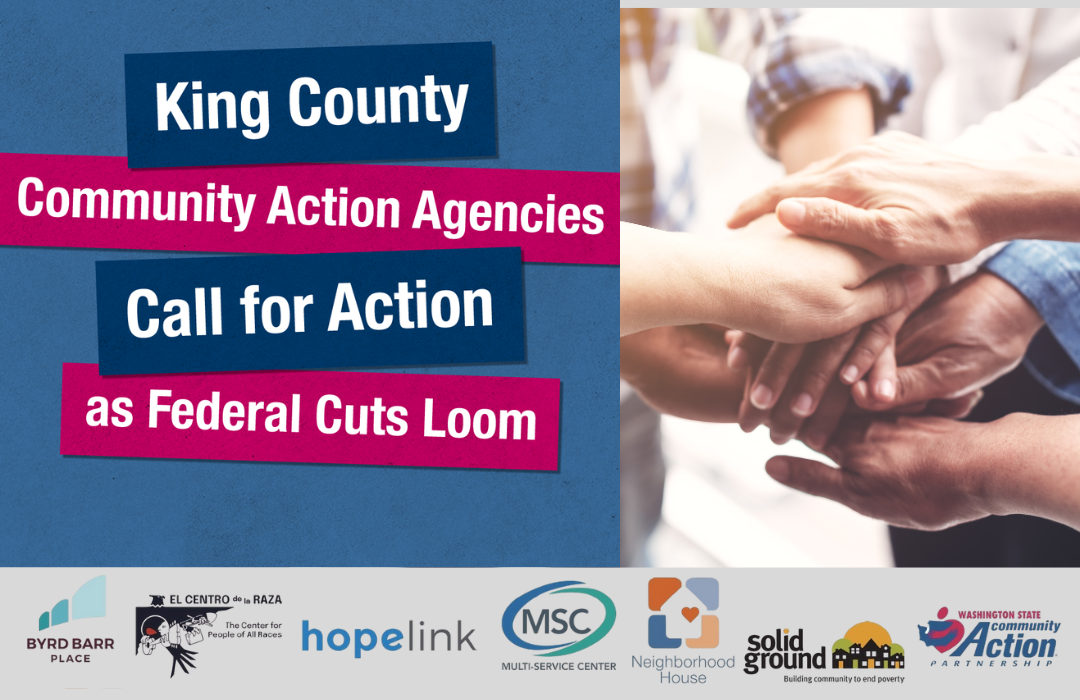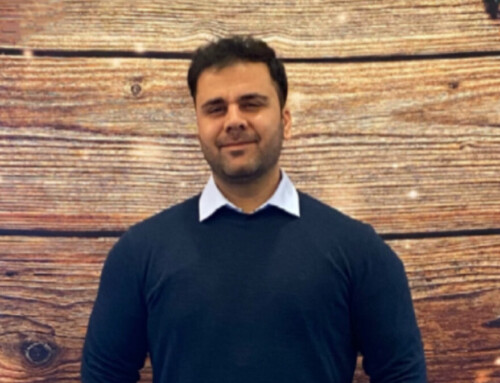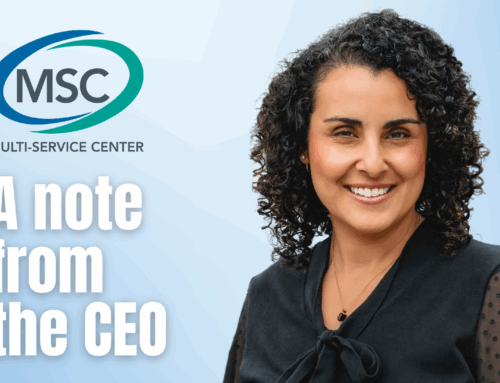Budget proposals would devastate regional nonprofit sector’s ability to respond to economic crisis, agencies warn – leaving hundreds of thousands of community members in King County without critical resources.
King County’s Community Action Agencies Byrd Barr Place, El Centro de la Raza, Hopelink, Multi-Service Center, Neighborhood House, and Solid Ground are together calling for action to protect the vital network of programs that serve the region’s most vulnerable community members. As Congress’ negotiations to reconcile its proposed budget with the White House’s FY2026 discretionary request continue, the six agencies warn that without a bipartisan agreement that includes funding for essential human services, these programs could face severe reductions or shutdown.
“For years, Community Action Agencies and nonprofits have served as our nation’s safety net, leveraging taxpayer and private support to provide critical services for our neighbors and communities when they are at their most vulnerable,” said Shalimar Gonzales, CEO of Solid Ground and President of Washington State Community Action Partnership. “The near daily onslaught of cuts to federal funding for nonprofits threatens to erode our ability to play this crucial role in American society.”
With Congress working to align competing FY2026 budget proposals and secure new appropriations for the following fiscal year, the threat to anti-poverty programs is growing on both fronts. Proposed discretionary budget calls for a 10 percent cut to the Temporary Assistance for Needy Families program (TANF), a 20 percent cut to the Supplemental Nutrition Assistance Program [(SNAP), NCSL, 2025)], a cut of approximately $32.9 billion to the Department of Housing and Urban development, and the full elimination of the Community Services Block Grant (The White House, 2025) .
Congressional budget resolutions signal even deeper reductions by targeting mandatory spending across safety net programs. An analysis of the House Energy and Commerce Committee’s preliminary budget showed a $715 billion cut from Medicaid (NCN, 2025). If either version is adopted, King County agencies and nonprofits will lose tens of millions in annual funding; gutting food access, cash assistance, housing stability programs, and other services for tens of thousands of people, including over 265,000 individuals supported annually by the King County Community Action Agencies.
“When funding for critical services is cut, the impact is far reaching and goes beyond just those who are unable to access food from food banks, or keep their homes lit and warm, or maintain their housing,” said Kirsten York, CEO of Multi-Service Center. “The economy and our communities suffer when the level of need rises due to dismantling of the safety net of services that support folks meeting their basic needs to have the ability to focus on other facets of their lives.”
During past economic crises like the Great Recession and the COVID-19 pandemic, nonprofit organizations became critical lifelines, supported by programs that reinvested taxpayer dollars into local communities to help stabilize families and rebuild regional economies.
Now, as federal programs face proposed reductions or elimination, communities may be left without the support systems needed to weather future economic instability. Human services nonprofits in the Seattle metro area alone employ more than 42,000 people (US Census Bureau, 2022), and closures or service reductions would not only leave families without essential care, but would also result in job losses and broader economic fallout.
The urgency is even greater in high-cost areas like King County, where a single adult needs an estimated $119,392 annually to meet basic needs and live comfortably — and a family of four (two working adults and two children) requires nearly $283,712 to maintain the same standard of living (SmartAsset, 2024). Without sustained federal investment, the gap between community need and available support will grow, leaving both individuals and nonprofits without the resources to respond.
“The instability of funding adds additional strain when we are problem solving and braiding funds in order to continue to serve our community but, have to respond to the unknown of whether the funds will be frozen or even exist day after day,” said York.
The $715 billion cut to Medicaid would leave the Washington State Legislature to fill a multi-billion-dollar budget gap, likely forcing a special session if enacted. In the 2023 fiscal year, Washington received more than $12.5 billion in federal Medicaid funding (Mascaro, 2025). The cuts would strip 61,000 rural residents and 210,000 children in Washington of their health coverage (JEC, 2025). Over 20 percent of Washington’s population is covered by Apple Health, the state’s Medicaid program.
“Severe cuts to Medicaid will not achieve cost savings in any way. The only real outcome from these costs will be harm to families who depend on Medicaid for daily support,” said Janice Deguchi, CEO of Neighborhood House. “Our healthcare system is already challenging to navigate and cutting services to families will create even larger gaps in basic services. The true, long-term impact of major cuts to Medicaid is impossible to quantify.”
In addition to these cuts, reductions in SNAP, TANF, and the elimination of the Community Services Block Grant would significantly impact the agencies’ operational budgets, especially for their food assistance programs – while regional hunger continues to climb.
Data collected by the Washington State Department of Agriculture showed food bank visits rose by 18 percent across the state in 2024 (WSDA, 2024). If the proposed 20 percent cut to SNAP takes effect, an estimated 888,300 Washingtonians would lose all or some of their benefits used to purchase food, impacting an estimated 5,000 authorized retailers (Bergh, 2025).
“Collectively, we have all seen an increase in the need for not only our services, but the support that critical federal programs were designed to provide,” said Meghan Altimore, CEO of Hopelink. “With the cost-of-living continuing to rise in this already expensive region, I am deeply afraid of what these cuts to food assistance programs, Medicaid and Medicare, and housing assistance – such as Section 8 – would do to the people already struggling. We are asking everyone to reach out to their elected officials in Washington, D.C. in support of these programs and to share the message widely about why these cuts are dangerous.”
The organizations encourage community members to elevate concern to their elected representatives that their federal tax dollars should be returned to their local communities as intended. Monetary donations can also help fill budget gaps while volunteering can also help sustain programs as demand grows.
Dr. Angela Griffin, CEO of Byrd Barr Place, says the public’s support was vital as it met unprecedented community needs during the pandemic.
“The generosity of donors and volunteers made it possible for the organization to expand food access, keep families housed, and offer essential support when it mattered most,” she said. “With new funding threats on the horizon, that same level of public and philanthropic commitment is needed now more than ever. Local nonprofits like ours are vital to community resilience, and we can’t do this work alone.”
The six King County agencies are among the 30 Community Action Agencies serving Washington and are represented by the Washington State Community Action Partnership. Community Action was born out of the Economic Opportunity Act of 1964 and now includes a nationwide network of roughly 1,100 agencies funded through the Community Services Block Grant to develop and deliver anti-poverty solutions tailored to local needs.
“Community Action is an accountable, effective, locally driven network that changes lives and improves communities throughout the state and country,” says Jeff DeLuca, Executive Director of Washington State Community Action Partnership. “From AmeriCorps to hunger programs, we are already seeing cuts and cancellations impact our members statewide, especially in rural communities. We are proud to support this effort and raise the alarm about these extreme threats to stability and opportunity for the 700,000 Washingtonians who count on Community Action every year.”
Washington’s Community Action Agencies contribute an estimated $750 million annually to the state’s economy and employ around 4,000 people. The joint advocacy response by King County’s Community Action Agencies to proposed federal cuts is the first of its kind.
“Solidarity is what holds us together when systems fail us,” said Estela Ortega, Executive Director of El Centro de la Raza. “We cannot wait for permission to care for one another—we must act now to protect our communities with the urgency and love they deserve.”





